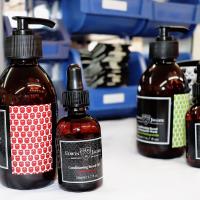 Add My Company
Add My Company
Sign In

What bottle labelling services do Dura-ID offer?
It is essential to ensure that your bottle labelling not only looks great, but matches up with proper safety standards so that your customers can safely consume or use the products contained within. But what needs to happen to ensure your bottles are the best of the best?
What bottle labelling options are there in the food industry?
Dura-ID gives you the option to carry out bottle labelling in-house. We will install one of our world-class thermal transfer, laser or inkjet printers at your premises and you will be able to print bottle labelling products in a range of sizes and colours that fit your unique brand.
All our bottle labelling is approved for use across Europe by the EU and our full colour in-house printing options mean that no minimum order quantities are required.
Our solutions provide bright, appealing labels, especially if you want to add the personal touch. For example, bottle labelling through a Dura-ID printer in-house could give you the opportunity to make a run of personalised bottles that are ideal for Christmas, Halloween or Valentine’s Day gifts.
If you are looking to print a small batch of products, or perhaps trial different versions of a printing product if you are experimenting with your brand, then bottle labelling from Dura-ID gives your organisation the perfect in-house printing solution you need.
Bottle labelling design software, printer consumables and maintenance agreements can also be supplied if you need reliable and quality printing on demand.
What bottle labelling options are there in the chemical industry?
Of course, bottles are not just used in the food industry. When it comes to chemicals, ensuring you are handling materials in the correct way can literally be a life-or-death matter.
This is why you can always rely on in-house bottle labelling from Dura-ID if you need to print labels for bottles in a laboratory or other chemical setting.
Any bottle labelling that includes chemicals must include hazard pictograms such as GHS diamonds and IMDG labels. These symbols give consumers accurate information about how to safely use the product inside and to be aware of any dangers associated with the item produced. This information falls under The Classification, Labelling and Packaging of Chemicals (Amendments to Secondary Legislation) Regulations 2015.
When classification criteria is met under the CLP legislation, the physical, health, environmental or other hazards of the substance must be identified and communicated to everybody in the supply chain, including consumers.
This communication allows consumers to be alert to the presence of a hazard and take associated steps to manage the risk, whether that be response, storage, disposal or more.
Of course, it is important to ensure that labelling looks aesthetically pleasing as well as providing vital information for consumers. Ensuring that any hazard symbols are clear and easy to understand is vital. But durability is also an important factor. Labels need to withstand extreme hot or cold temperatures so that any barcodes and other information stay intact and readable, potentially for years to come.
What bottle labelling printing machinery should you use?
The OKI Pro 10 Series is perfect for bottle labelling in the food and chemical industries. With full CMYK full colour printing on a range of materials, this series of printer produces high quality labels that you can rely on.
The OKI Pro 10 Series offers high print resolution and boasts various configurations to suit your requirements.
As well as aesthetically pleasing labels, the short run label prints ensure that wastage is kept to a minimum.
For more information on What bottle labelling services do Dura-ID offer? talk to Dura-ID Solutions Limited
Enquire Now
List your company on FindTheNeedle.

